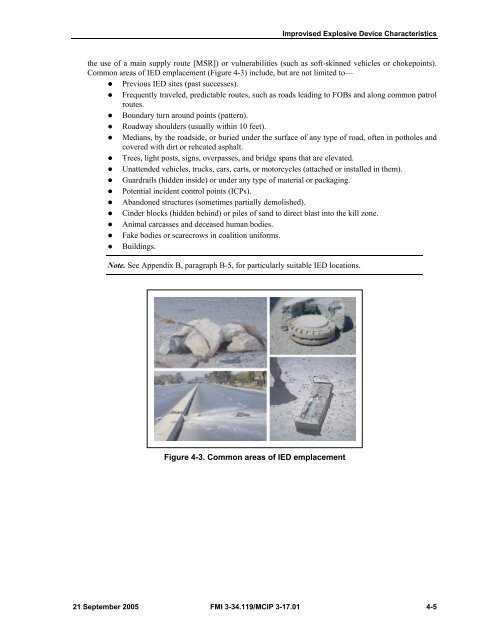Chapter 4• Hoax IEDs which the enemy uses for a myriad of purposes, such as to learn our TTP,entrapment, nonexplosive obstacle, and development of complacency for future IED attacks.Hoax IEDs include something resembling an actual IED, but have no charge or a fullyfunctioning initiator device.4-8. IEDs can be designed to attack specific targets, such as high-visibility targets, high-value targets(dignitaries), and military targets, such as―• Quick-reaction forces (QRFs) and first responders.• Cordons.• Checkpoints and control points.• Logistics movements or combat patrols.• Anywhere that a targetable pattern has developed.Note. Secondary and tertiary IEDs should be expected in the area.INDICATORS4-9. The primary indication of an IED will be a change in the environment (something new on the routethat was not there yesterday). The enemy may leave behind visual indicators of an emplaced IED byaccident or on purpose (to inform the local population). Vigilant observation for these subtle indicators canincrease the likelihood of IED detection by friendly forces before detonation. Examples of possibleroadside IED indicators include, but are not limited to—• Unusual behavior patterns or changes in community patterns, such as noticeably fewer people orvehicles in a normally busy area, open windows, or the absence of women or children.• Vehicles following a convoy for a long distance and then pulling to the roadside.• Personnel on overpasses.• Signals from vehicles or bystanders (flashing headlights).• People videotaping ordinary activities or military actions. Enemies using IEDs often tape theiractivities for use as recruitment or training tools.• Suspicious objects.• Metallic objects, such as soda cans and cylinders.• Colors that seem out of place, such as freshly disturbed dirt, concrete that does not match thesurrounding areas, colored detonating cord, or other exposed parts of an IED.• Markers by the side of the road, such as tires, rock piles, ribbon, or tape that may identify anIED location to the local population or serve as an aiming reference (such as light poles, frontsor ends of guardrails, and road intersections or turns).• New or out of place objects in an environment, such as dirt piles, construction, dead animals, ortrash.• Graffiti symbols or writing on buildings.• Signs that are newly erected or seem out of place.4-10. Friendly forces should be especially vigilant around—• Obstacles in the roadway to channel convoys.• Exposed antennas, detonating cord, wires, or ordnance.• Wires laid out in plain site; these may be part of an IED or designed to draw friendly forceattention before detonation of the real IED.LOCATIONS4-11. IEDs may be emplaced anywhere that enough space exists or can be created to hide or disguise theIED. Whenever possible, devices are located where employment can exploit known U.S. patterns (such as4-4 <strong>FMI</strong> 3-<strong>34.119</strong>/MCIP 3-17.01 21 September 2005
Improvised Explosive Device Characteristicsthe use of a main supply route [MSR]) or vulnerabilities (such as soft-skinned vehicles or chokepoints).Common areas of IED emplacement (Figure 4-3) include, but are not limited to—• Previous IED sites (past successes).• Frequently traveled, predictable routes, such as roads leading to FOBs and along common patrolroutes.• Boundary turn around points (pattern).• Roadway shoulders (usually within 10 feet).• Medians, by the roadside, or buried under the surface of any type of road, often in potholes andcovered with dirt or reheated asphalt.• Trees, light posts, signs, overpasses, and bridge spans that are elevated.• Unattended vehicles, trucks, cars, carts, or motorcycles (attached or installed in them).• Guardrails (hidden inside) or under any type of material or packaging.• Potential incident control points (ICPs).• Abandoned structures (sometimes partially demolished).• Cinder blocks (hidden behind) or piles of sand to direct blast into the kill zone.• Animal carcasses and deceased human bodies.• Fake bodies or scarecrows in coalition uniforms.• Buildings.Note. See Appendix B, paragraph B-5, for particularly suitable IED locations.Figure 4-3. Common areas of IED emplacement21 September 2005 <strong>FMI</strong> 3-<strong>34.119</strong>/MCIP 3-17.01 4-5
















